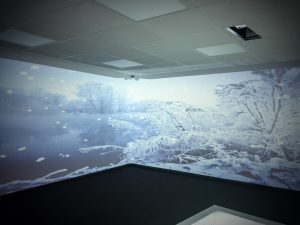Author: Oliver Wood 31st March 2017
Yesterday Debra James and myself went to Corpus Christi Catholic Primary School on a fact finding mission around their four dimensional learning space. Corpus Christi offers provision for students from Nursery through to Year 6, and aims to provide a holistic and interactive learning experience for students from the community.
Whilst Corpus Christi does a huge amount of excellent work in engaging students with hands on, immersive learning environments, we were particularly interested in their four dimensional learning space. We spotted this exciting learning resource through various news articles from the BBC and Coventry Telegraph respectively, and thought ‘hang on a minute, could this be used in Higher Education?’.
The first thing which struck me when we arrived was the welcoming atmosphere of the school campus. The place felt warm and welcoming and had a certain air of comfort surrounding it. The buildings were clean and bright, and the staff friendly and bubbly - just how you imagine a poster-primary school. Whilst waiting to meet the principal we were welcomed into the staff room, where a teacher was preparing Indian curries for an experience day with students (in which they would later use the four dimensional teaching space).
We then went to meet Donna Newman, principal for the school to speak about their experiences with the space, and talk about how the students have found the learning environment. Donna then took us to see the space.

What was the space?
In essence, the space consisted of a system of three, interactive projectors. These were hooked up to a sound system, producing an immersive environment which could be tailored to a number of situations. One such situation which has been used by the school was for the teaching of anatomy. In this session, the teacher made the floor into the human heart, with the walls the bloodstream. Then, as the teacher moved over different elements of the heart, the interactive projector kicked into action to reveal the interior elements of the heart and how they interact. Clearly, this kind of immersive experience can have huge impacts on engagement and retention of knowledge.
At Coventry, a lot of work has been done around the use of Virtual Reality to create immersive learning experiences for students. Whilst this work is exciting and has huge potential (see the 360 Immersions project), the drawback I always find with VR is the impact of the latency and the resulting feeling of sickness in users (myself included). By creating fully immersive physical environments, all be it overlaid with digital enhancements, the latency problem is removed whilst having the added benefit of been able to provide community learning experiences which are not reduced to an individuals experience. Large groups of users can interact with the space at once, something which is not widely possible in a virtual reality scenario. It is this shared learning experience combined with the immersive nature of space where I feel real value in the learning experience could be obtained.
I would like to thank Donna and the team at Corpus Christi for their warm welcome, and look forward to having conversations with them about this exciting project in the future.
